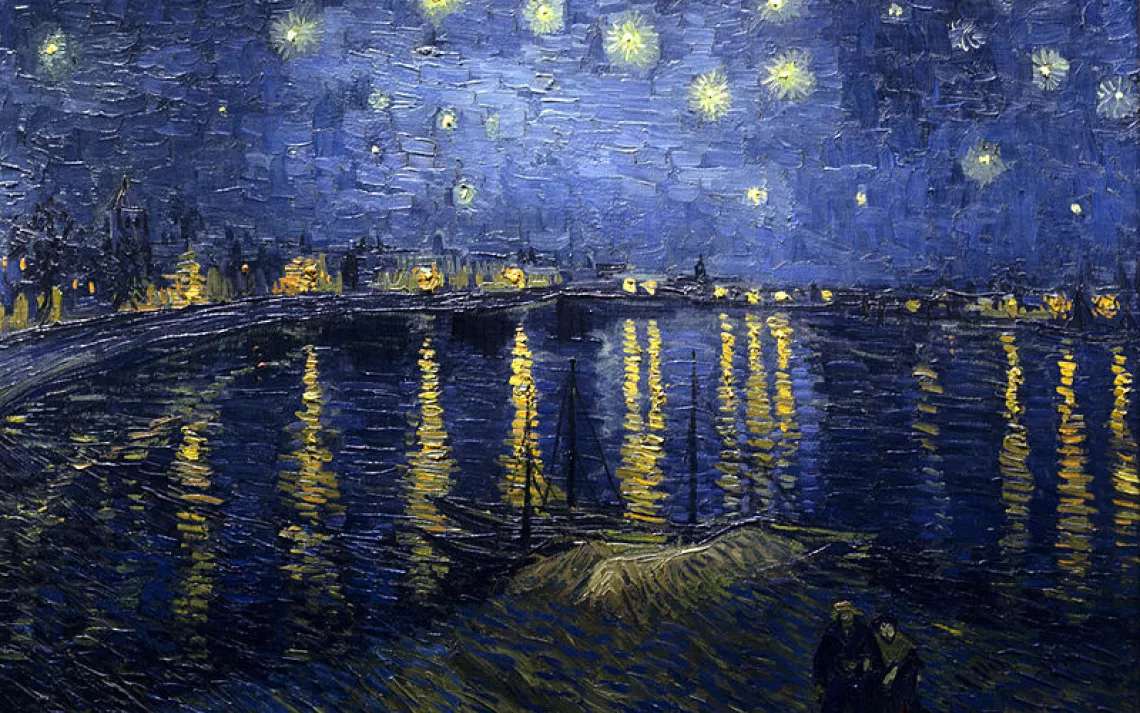June Observing Highlights

Vincent van Gogh painted a moving cluster in his Starry Night Over the Rhone. | Image by Vincent van Gogh
After sunset in June, the Milky Way will rise in the east, bringing with it many sights for backyard telescopes. This part of the sky is best viewed when the full moon is out of the way. On June 1 a nearly full moon ascends not far from Saturn and the claws of Scorpius. It reaches full phase the next morning, at 9:19 a.m. PDT. The first two evenings of the month it will be more than 99-percent lit. Then, as it wanes over the next couple of evenings, the moon will cross over the Milky Way, rising later and later, until the Milky Way appears above the horizon with no stray moonlight to interfere.
Scorpius and Sagittarius follow Saturn up from the southeastern horizon, while more to the east and northeast the Summer Triangle will appear with its constellations of Aquila, Lyra, and Cygnus. The moon will not return to the region of sky containing the summer Milky Way until the last days of the month. On June 28 the moon and Saturn will be less than two degrees apart.
Saturn, which glows at magnitude 0.1 and can be found in the later evenings in the south-southeast, is between the constellations Libra and Scorpius. Saturn is a treat through a telescope with its ring system and large moon Titan.
The reddish star below Saturn is Antares. It is surrounded by a cluster very rarely observed because it has no central core. Known as the Antares Moving Cluster, it encompasses a large portion of the constellation Scorpius. Within the Antares Moving Cluster and just over a degree to Antares’s upper right is a more traditional cluster, M4, a globular cluster 7,200 light-years away—one of the closest such clusters to Earth. M4 shines at magnitude 5.4, making it easy to spot with binoculars or a telescope. Some of the stars in this cluster may be 13 billion years old.
Moving Clusters may not be something you’ve heard of before, but one of the most recognized collections of stars in the night sky is part of one: The Ursa Major Moving Cluster, sometimes called Collinder 285, is also known as the Big Dipper. These stars all show a common proper motion.
Back in the west, Venus and Jupiter are dominant as these two bright planets move closer together. On June 2 Venus lines up with the stars Castor and Pollux to its right. Then Venus leaves Gemini for the constellation Cancer and the grouping of stars known as the Beehive Cluster. June 13 is the best day to observe Venus as it makes a picturesque pairing with this fuzzy collection of stars.
On June 19 a crescent moon lies below Venus, with Jupiter to the upper left. On the next night the trio forms a wide triangle, with the crescent moon and Venus as two bases and Jupiter above. By June 21 the moon has moved off to keep the star Regulus company.
Venus and Jupiter continue to get closer together until June 27 when the pair is less than two degrees apart. You can try to capture them both in the same field of view in a telescope until the end of the month. On June 30 the two brightest planets are only 20 arcminutes apart.
The June solstice brings summer to the Northern Hemisphere on Sunday the 21st at 9:38 a.m. PDT. Longer sunlight means observing is often poor until after 10 p.m. when the skies are finally getting dark, and even later (much later) for places farther north. In Anchorage, Alaska, astronomical twilight lasts all night in early May and then disappears altogether until August, when it returns to last all night again, making northern locations such as this particularly poor to summer stargaze from (or watch fireworks).
 The Magazine of The Sierra Club
The Magazine of The Sierra Club







